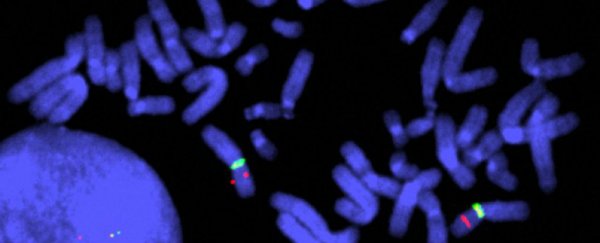In high school, we're taught that in the nucleus of every cell, DNA molecules are tightly packed around proteins called histones to form our chromosomes.
But new research has found that there's a whole lot more to chromosomes than the 25,000 or so genes they contain - scientists have found that a mysterious 'sheath-like' structure accounts for up to 47 percent of every chromosome.
For more than a century, our understanding of chromosomes has been based on the assumption that they're made from a complex of DNA and histone proteins called chromatin, formed within the nucleus of each cell.
Since their discovery in 1882, chromosomes have been the subject of intense study, but the details of their internal structure have eluded us, in no small part because chromosomes are completely invisible in the cell's nucleus - unless the cell is dividing.
When a cell divides via meiosis or mitosis, the chromatin inside becomes more tightly packed, causing the chromosomes to become 'supercoiled' and visible under a microscope.
Most of what researchers know about chromosomes was found by observing chromosomes during cell division, but because we can only observe them under certain conditions, we've been working with an incomplete picture of what a chromosome actually looks like.
To improve our ability to view the internal structures of chromosomes, researchers from the University of Edinburgh in Scotland developed a new method called 3D-CLEM, which combines light and electron microscopy with computational modelling software to produce the first high-resolution three-dimensional images of all 46 human chromosomes.
After modelling the length, width, surface area, volume, and DNA packing density of all normal human chromosomes, they found something that could have big consequences for our basic understanding of a chromosome's internal structure.
"Defining the structure of all 46 human chromosomes for the first time has forced us to reconsider the idea that they are composed almost exclusively of chromatin - an assumption that has gone largely unchallenged for almost 100 years," says one of the team, biologist Daniel Booth.
In their analysis, Booth and his team found that chromatin only accounted for between 53 and 70 percent of the total contents of chromosomes.
A structure called the chromosome periphery - something that researchers have caught glimpses of in the past, but had no way of knowing how extensive it was - accounted for the remaining 30 to 47 percent of the 46 chromosomes.
That means for any given chromosome, DNA and its supporting proteins might only account for half of the total contents.
"This first application of 3D-CLEM analysis yielded the remarkable, and surprising, conclusion that a very large percentage of the total volume of mitotic chromosomes is not composed of chromatin, but is instead in the periphery compartment," they report in their paper.
At this stage, it's unclear what the function of this structure actually is, but the researchers suspect it could act as a kind of 'sheath', keeping chromosomes isolated from each another during cell division.
This is supported by previous research indicating that the structure is at least partly formed as a result of the protein Ki-67 - a marker for cellular proliferation that binds to the chromosome surface to keep sister chromatids separate.
If this really is the function of the chromosome sheath, it means the structure plays a crucial role in preventing errors from occurring when cells divide - something that can lead to birth defects and various forms of cancer.
Other than its function, there's still a lot we don't know about this mysterious structure - we're not sure if it acts like a liquid or a solid film, and it's not clear how it influences the structural changes of chromatin during cellular division.
So it looks like it's back to the drawing board for one of the most fundamental constituents of a living cell.
As one of the team, Bill Earnshaw, says: "We now have to re-think how chromosomes are built and how they segregate when cells divide, since the genetic material is covered by this thick layer of other material."
The research has been published in Molecular Cell.
